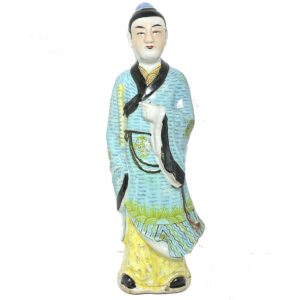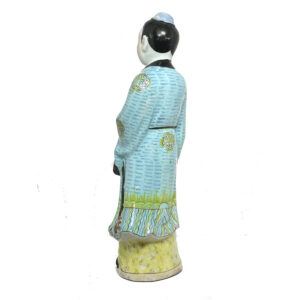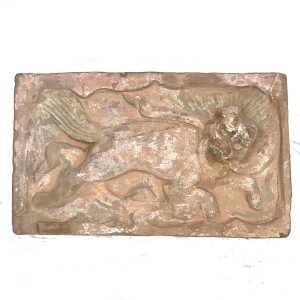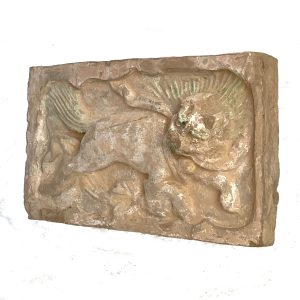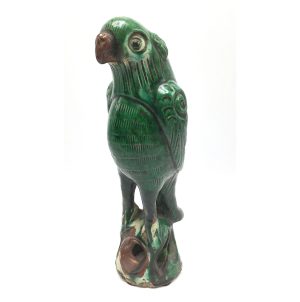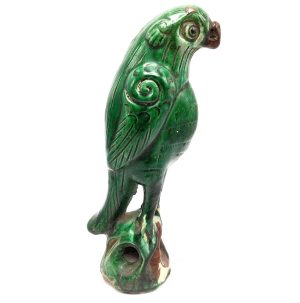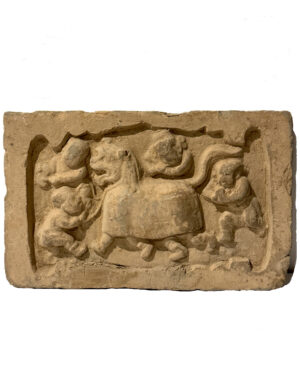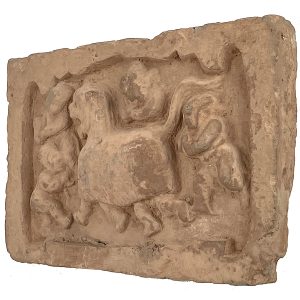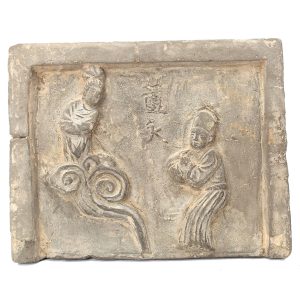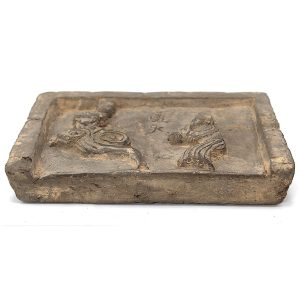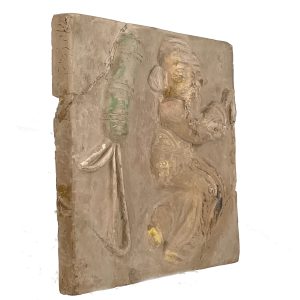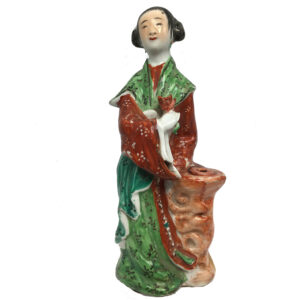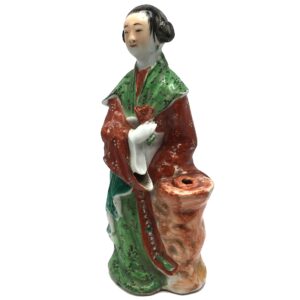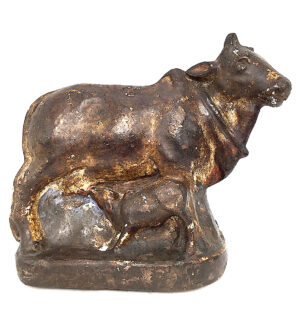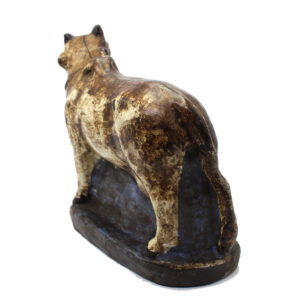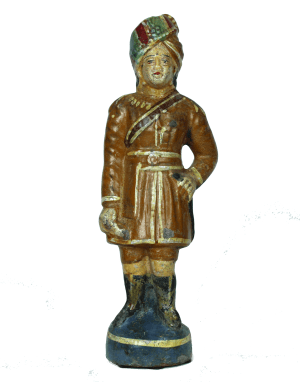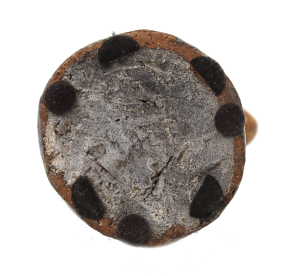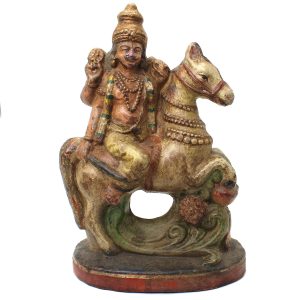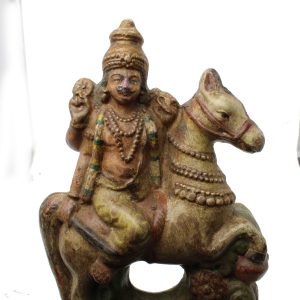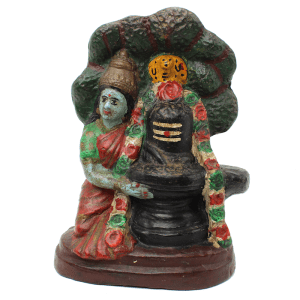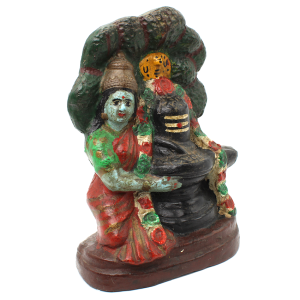“Antique Puppet Head with Top Bun, China (5274BCE) SPECIAL PRICE” has been added to your cart.
Continue shopping
Showing 73–84 of 84 results
-


$295.00
H: 12” W: 4.5” D: 3” | FREE SHIPPING WITHIN CONTINENTAL U.S.
This elegant Chinese Republic Period porcelain is the Taoist immortal Han Xiangzi carrying his auspicious flute dressed in a beautiful blue robe with wide black borders, fine internal decorations and a decorative yellow floral undergarment. On the bottom is the kiln seal. As the patron saint of musicians and florists, it is a great gift for someone who enjoys these pursuits.
-
Sale!


$485.00 Original price was: $485.00.$395.00Current price is: $395.00.
The Song dynasty (960–1279) is considered the most culturally brilliant era in later imperial Chinese history. A massive expansion during this dynasty produced government, public and religious buildings and tombs with walls decorated with earthenware unglazed mold-made brick tiles. Some were purely decorative and others were wishes for happiness and comfort in the deceased’s afterlife…
-


$295.00
SOLD H: 9″ W: 3 ” D: 3.5 ” | FREE SHIPPING!
Chinese Republic ceramic parrots are commonly depiction as this one perched on an open rocky base. Porcelain parrots were produced for the domestic and export markets and sometimes sold in pairs leading some to believe they, like pairs of fish, symbolized the love and fidelity of married couples. This one has vivid polychrome colors, large eyes and stylized wings. This piece is in excellent condition.
-
Sale!


$465.00 Original price was: $465.00.$350.00Current price is: $350.00.
H: 6.26″ W: 9″ D: 1.625″ | CALL 213-568-3030 OR EMAIL [email protected] FOR SHIPPING.
This late Song brick tile portrays a feasting couple with a figure points to a stylized image of a bat flying (for good luck) in the sky.
-
Sale!


$495.00 Original price was: $495.00.$395.00Current price is: $395.00.
H: 7.25 ” W: 11.5″ D: 1.75 ” | FREE SHIPPING WITHIN CONTINENTAL U.S.!
Song brick tiles like this decorated government, public and religious buildings, often depicting mythical animals, auspicious objects and holiday celebrations. This tile shows a traditional lion dance performed at Chinese New Year to attract prosperity and good luck for the coming year.The lion is flanked by 2 frightened children and a person in anjali mudra, symbolizing composure that could counter balance the children’s fear.
-


$445.00
Chinese funerary tiles, as forms of mingqi adorned tomb as early as the Han dynasty depicting everyday scenes, entertainment, mythical beasts, folklore, history, literature and poetry. A Han stone tomb relief rubbing in Stories from China’s Past (p. 173) labeled “Ascending to Heaven in Deer Chariot” is reflective of this Song brick-tile. During the Song…
-
Sale!


$495.00 Original price was: $495.00.$325.00Current price is: $325.00.
H: 7” W: 5” D: 2.75” | FREE SHIPPING WITHIN CONTINENTAL U.S.
This Song earthenware tile depicts the legendary scholar, poet and alchemist Taoist deity Lu Dongbin, one of the Eight Immortals, who sought to discover the elixir of immortality and used charms still used in Chinese homes to prevent illness and ward off evil. He and his fly whisk are auspicious symbols of longevity and a wish for immortality. Firecrackers, are traditionally used to celebrate the Chinese New Year, to bring in wishes for a safe and prosperous year, scare away evil and provide pleasure for the ancestors’ spirit.
-


$240.00
Ht: 9.75″ W: 3.5″ D: 2.5″ | FREE SHIPPING WITHIN CONTINENTAL U.S. !
This Chinese Republic Period delicate porcelain figurine holds a rose at her heart in her right snow white hand, her left arm covered by her shawl resting on a waist-high decorative vase with an opening to hold incense (joss) sticks. Her shawl drapes over her shoulders and lower garment with floral motifs extending to the beaded belt at her waist. The sweet facial expression with slightly smiling bowed lips is framed by her piled hair looped in a chignon over each ear. Given her luxurious garments and accessories, she is an aristocratic woman. The rose was often used on porcelains during this period, representing eternal spring.
-
Sale!


$105.00 Original price was: $105.00.$85.00Current price is: $85.00.
H: 7″ W:8.25″ D: 3.125″ | FREE SHIPPING WITHIN CONTINENTAL U.S.!
Vintage bivalve mold figures like this cow were hand luted and hand painted, in the likeness of Hindu religious figures, soldiers, animals are used in rural India where they are seen as wishes for a better life.
-


$105.00
Earthenware terracotta pottery has played a significant role in the cultural, religious and artistic traditions of India for centuries. Indian terracotta images are considered spiritual, mystical and auspicious as Hindus believe terracotta incorporates the five natural elements of air, fire, earth, water and metal. Made with a bivalve mould that is hand luted and hand…
-


$145.00
Earthenware terracotta pottery has played a significant role in the cultural, religious and artistic traditions of India for centuries. Indian terracotta images are considered spiritual, mystical and auspicious as Hindus believe terracotta incorporates the five natural elements of air, fire, earth, water and metal. Made with a bivalve mould that is hand luted and hand…
-


$165.00
This painted earthenware terracotta Hindu devotional image (murti ) of Shiva and Parvati was used to help devotees in daily prayers (puja) focus and visualize the deities on their home altar. This image is both aniconic (symbolic, abstract, and non- representational) and figurative. Shiva’s image is represented by a symbolic round phallus – a lingham…
End of content
End of content

